
I think part of the reason for my passion as a coach was my inability to find someone to help me on my path to my athletic goals in my younger years. As Tony Holler mentioned, usually the best coaches are the ones who felt they came up short on their athletic careers. Maybe, it is meant to be part of our journey. We came up short on purpose so we could help others achieve their goals. Of the many things that I enjoy about what I do, this is really my favorite. I like to be the bridge to help an athlete accomplish their athletic goals. What is cool about the process is the ability to look back and see where they started and where they finished. I have had the opportunity and luck to be able to do this on many occasions. This athlete is one of the examples.
Shane Molidor was a jumper at Downers Grove South High School in suburban Chicago. It is a school of 3000 students. It had a reputation as a football school and had the wins to back it up. It could have been a track powerhouse, but the football coach didn’t see the crossover. He wanted BFS. In that process, he let Shane slip through the cracks. As a sophomore, he qualified for state in the long jump with a 21’7 and was a decent 100m dash runner. His junior year should have been a big year, but he broke his ankle on the first meet of the year, and the rest of the season was lost. One week after the season was over I received a call from his dad to see if I could help him. A few days later, Shane showed up at my house for an assessment. I filmed Shane as I do all athletes when they start with me and then constructed an initial plan of how to get him to his goal that he stated firmly in the first minutes of our conversation, “to be state champion in the Long Jump.” By the end of our journey together, he jumped jumped 23’4 which won the meet and ran 10.73, second fastest of the day in prelims, second fastest time of weekend. But on Saturday after he accomplished his goal of state champion in Long Jump, I think he was done mentally and ended 7th in the 100.
I am going to show you what I saw Shane do on our first day, tell you what I see on the film and discuss the plan that we created. I will then show the after film to see what we accomplished. The film speed, software, camera were both the same for both shoots. Thanks to Sony DVX210 and iMovie.
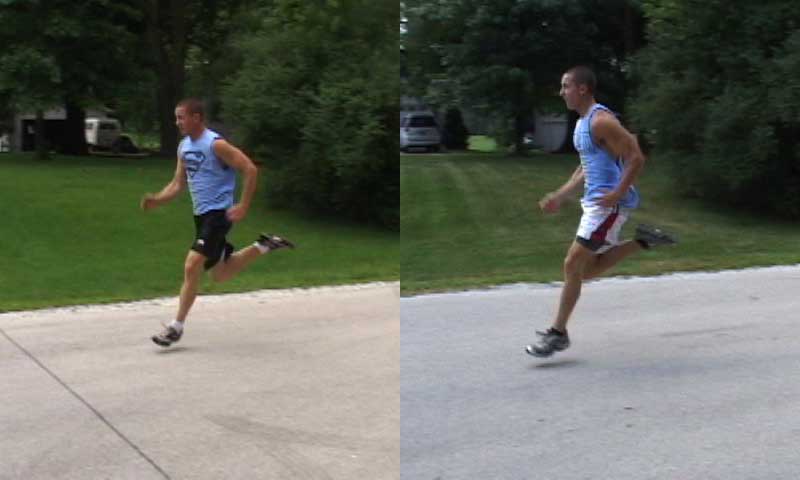
Frame 1: Here is my starting point. I call this pre-contact. It gives me an idea of where the foot is about to hit. Shane’s foot is about to turn out, so his contact will be on the side of his foot. It may have an impact. We need to wait to see from the front. His head is leading a bit, which would make me wonder what his driver is for hip flexion. In the after, notice how the arm timing is different. I am guessing that he is driving more from his glute at this point because the arm is not more out in front. And with the strengthening of his glutes and hips, notice how his foot is about to hit more squarely on the ground. This will have an impact on ground contact time. The foot won’t have to reposition on the ground to get a good push off the ground. We did a healthy diet of four-way hip and mini hurdles with a weighted bar overhead. We also did a series of foot rotation twists on a rotating disc incorporating using lower oblique and glute medius, and a series of exercises to develop adductors.
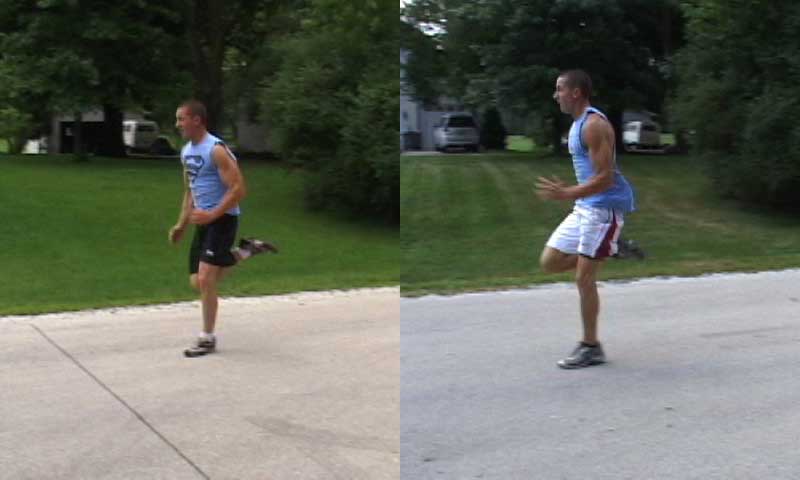
Frame 2: I call this touchdown or contact phase. Ideally, it is one frame. I think this frame is slightly past the touchdown. Shane’s contact is in front of his center of mass. It is not bad, but it is there. In this scenario, a runner usually has to resort to pushing his run somewhat or what we call a push runner who uses his quads to push the body forward. We would like to be pull runners where the athlete pulls his body forward with his gluts and hamstrings. What concerns me at this point is the swing leg knee is lower than his plant leg knee. This may have an impact when we see him from the front. Again, this is not bad but could be much better. Here is the after. Foot strike slightly more underneath but look how square the foot looks under the body. Posture is more upright in this position as well. He is also carrying his swing leg much higher. I like how his hand in extension too, triggering the brain to give power to extend.
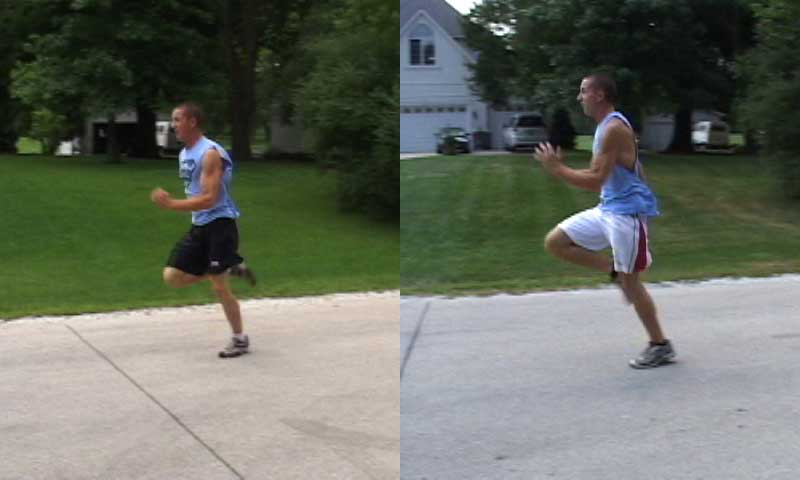
Frame 3: Center of mass has passed on this frame that is usually an important frame for me. It is a great shot to see how he lines up from head to toe and see how tall he is running. More importantly is the positioning of the swing leg knee. If the swing leg knee is even to or behind the plant leg knee, I know his timing is off. Based on Weyand’s research, we know that leg only have a certain amount of time to reposition themselves. If the knee is behind, it will never have time to get high enough for the center of mass to pass over and allow for a clean midfoot strike. I call this being late in the cycle. If an athlete is late in the cycle, he will never run fast, and it almost forces him to push his run. Or, he needs to use his quads and erectors to push himself down the track. To deal with, we did low hurdle (8-10 inches high placed 1.9-2.1 m apart for 20-30m) runs. This is a great way to train the timing of a sprint. If you are late, you fall. The body knows it. So, it forces perfect timing. The results speak for themselves in the second frame. He exhibits a high knee on the swing leg, a strong hip on the plant leg.
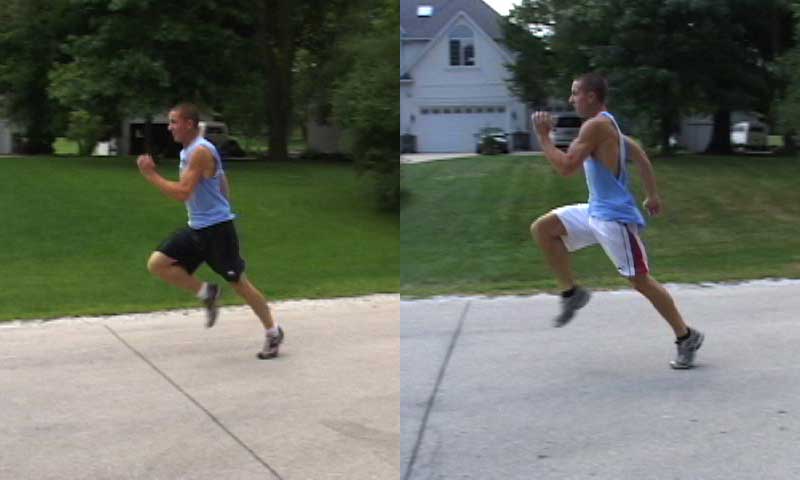
Frame 4: Shane is approaching toe-off. As his toe is coming off the ground, his knee is under his glute. This is a good take off position. Some bend and lack of full extension would be better. Lower leg of the swing leg could be tighter to the hamstring also. On the after position, it looks like he has more bend in the plant leg. Body looks like it is in more of a vertical push rather than a horizontal push, once again, thanks, Peter Weyand. Frans Bosch calls this positive running. It is the midpoint angle between his two legs. The more forward the angle, the better for the runner. This is where the drive comes to train front side mechanics.
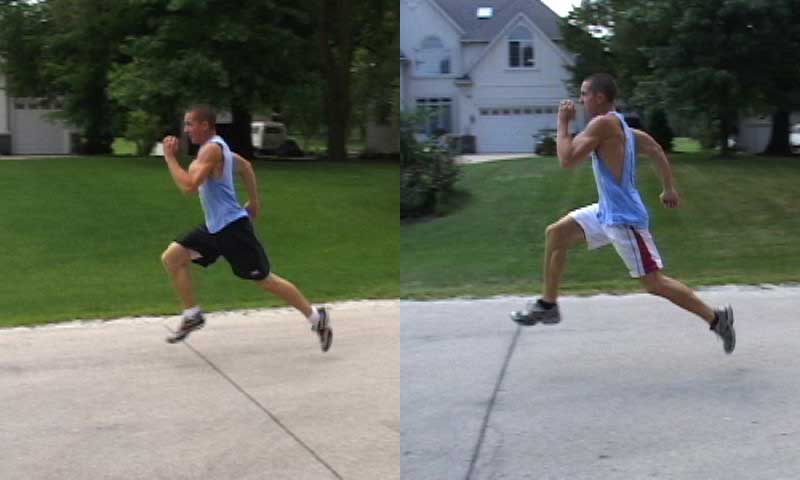
Frame 5: Air time! I am looking to see how much spinal change he has. His pelvis seems to be tilting forward. You can also see a curve in his spine as well. Usually, a dead giveaway that he is pushing his run. The quad has pushed so hard in a forward fashion that the hip rotates forward. Whereas, a more vertical push will allow the hip to stay more neutral. This is an indicator of why you may have a good 55m runner who can’t run a good 100 or a 100m football guy who can’t convert it to a 200. It costs too much energy to reposition the hips constantly over the 200m range.
Where a powerful pusher can get a great start and maintain speed, hopefully, long enough to win. Funny enough, Shane had hip flexor problems to begin. Quads were doing the work of the psoas. This is a problem with fast push runners. In the after frame look at Shane’s new pelvic position. It is horizontal with little pelvic tilt. There is vertical impulse on a rigid body. It is no different than bouncing an iron rod compared to a sandbag. Iron rod will bounce. Quicker plant leg off the ground. See how the trail leg lacks extension. This is a great before and after of a push vs. pull runner or horizontal vs. vertical impulse or the aftermath on that type of contact.
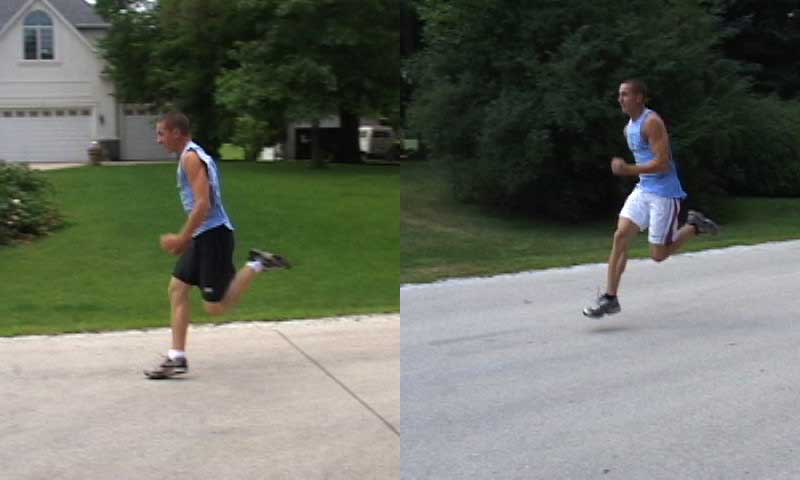
Frame 6: I skipped a few frames to get to pre-contact on the other leg. This one is further out in front. Again, he is crashing on the outside of his foot as well. It almost looks like he is going to try extra hard to push here. It looks like his head and shoulder a bunching up for a big push. In the after frame, much like the precontact on the other foot, his foot looks like it will have a flatter, quicker strike on the ground.
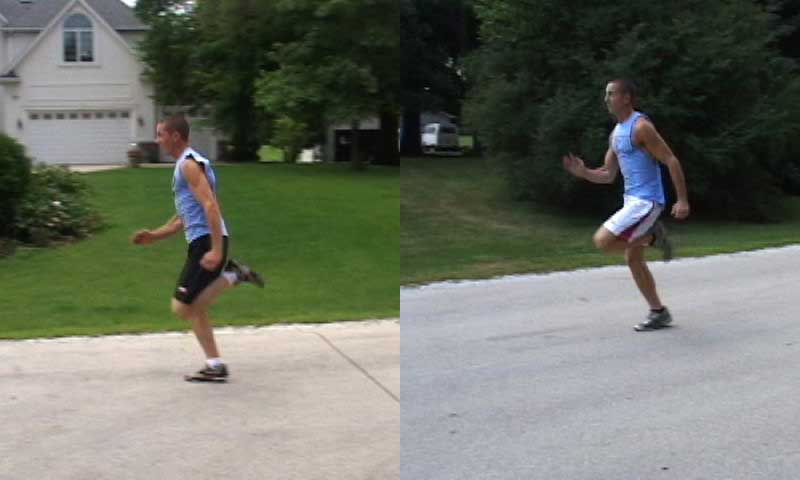
Frame 7: Midstance phase + a tiny bit. Great timing but he is leaning to the right, and the bottom of his foot is visible. Not a good sign. We will check it from the front. Like Frame 2, knee is in a much better position, and he is coming to his big which will give him a forward push. Pushing off the side of your foot will send your body in that direction and the body needs to compensate for that vector through vision. That is why it is not always a great idea to fix someone’s arms. Most of the time they are compensating for a foot extension in a different direction.
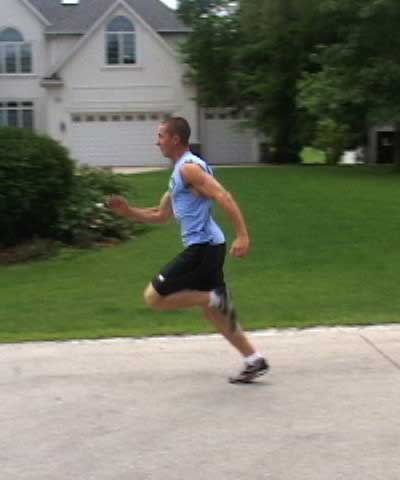
Frame 8: Toe-off – a tiny bit. Plant knee is in a good position, and he carries his trail leg higher than his other leg. Swing knee is in a good position as well.
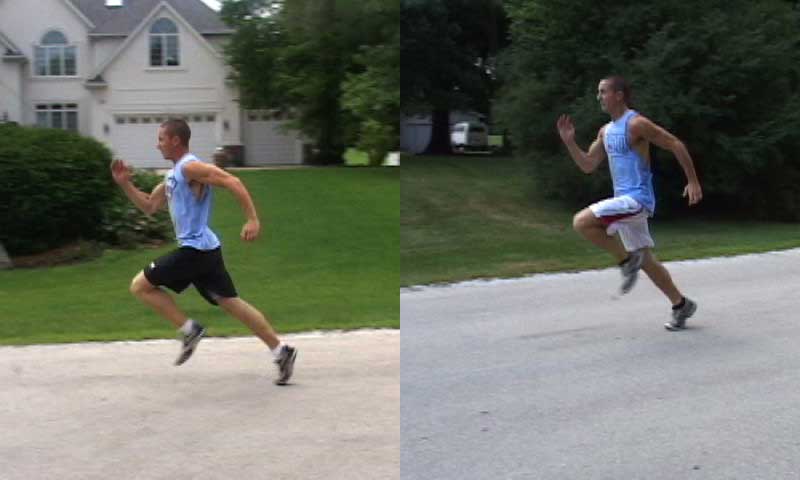
Frame 9: Toe-off. Better than his other side. Slight bend in the knee and some bend in the pelvis. Better than his other side. In the after frame, he is off the ground one whole frame faster than before. Again, knee is higher and just looks more powerful.
Overall, he is not in a horrible position from the side. He has some minor things that need work. From this we figured we would use a good, steady diet of prime time runs (stiff legged runs). This is a great drill to help teach and strengthen the body to get the foot under his hips on contact. The pelvic rock was a tougher issue. Did the rock come from a weakness in the obliques whose job it is to hold the pelvis in place while in the air? Or possibly the glute med that also holds the pelvis in place while foot is on the ground. Because his push is not terribly long, I didn’t think his push was causing the rock too much. But the prime times also tend to cure push runners.
To answer my question, I need t o look at the front.
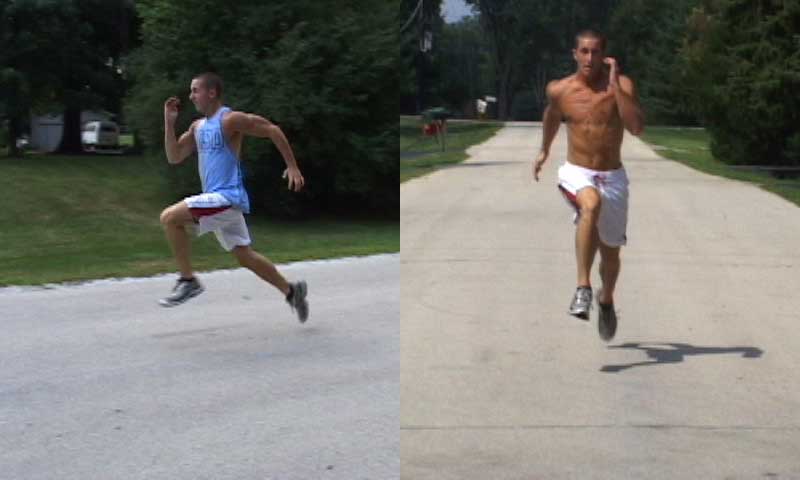
He took his shirt off for the front. Shane switches to “suns out, guns out” mentality.
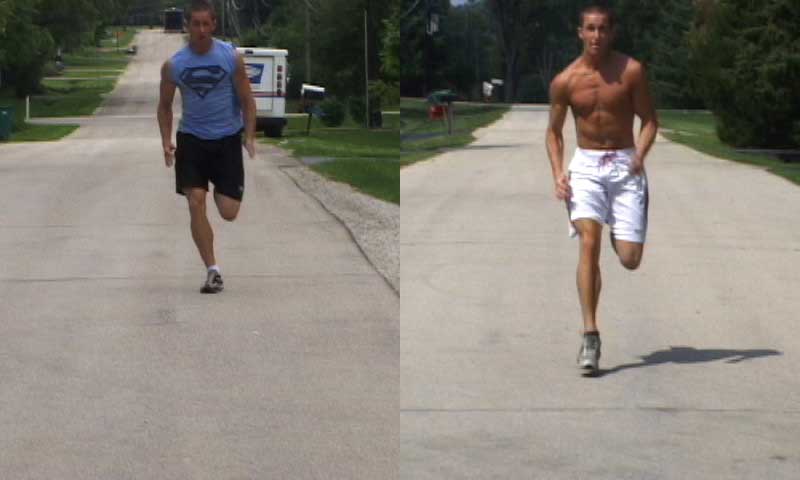
Frame 1: This is contact phase. He is landing on the outside of his foot initially. We need to see if he stays there. The natural progression is to roll on outside of foot to toes and the energy rolls to the big toe which launches the body. If he stays on the outside of his foot, he loses power from that leg. Contact time can be too quick because the body never has enough time to let the weight or energy push on the ground fully. In the after, his foot is going to hit solid and squarely on the ground that will eliminate the spin that needs to occur to go straight and get a good push. This is why he is faster off the ground.
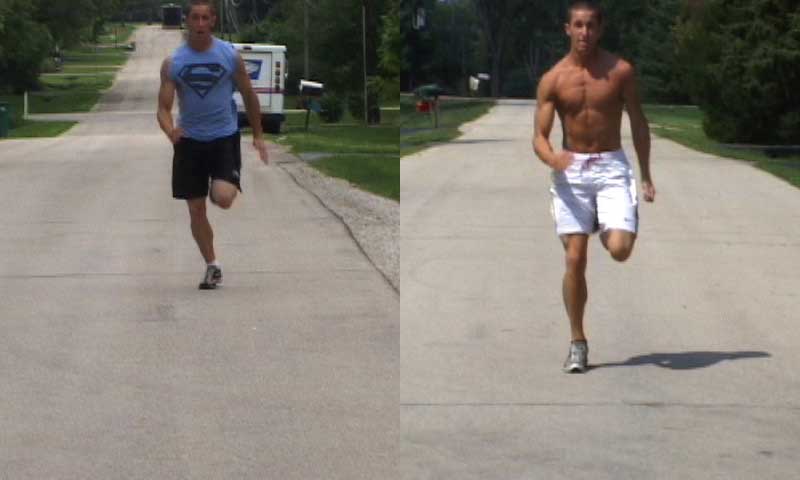
Frame 2: Midstance phase. This is my measuring frame. I check shoulder point to shoulder point and hip point to the hip point to see how level both of those lines are. Shane has a dip in his right shoulder. Usually, that is an indicator that something in his upper lateral chain is off, and I would test his lat to see how it is holding. The big clue is his foot. I measure from the outside of his heel and draw a line straight up. I measure to see how much of his body is outside that line. With Shane, it is a fair amount. I would say that his foot lands slightly past center to his left. This creates a scenario of his body repositioning itself so it can push forward safely. This not only takes time but is inefficient. Again this is something that a good 100m guy can get away with, but bomb the 200. But, the difference would make a great 100m guy. After, he is straight up and down along the outside of his heel. His hips are straight across. This is almost perfect. Look at the difference in his foot position.
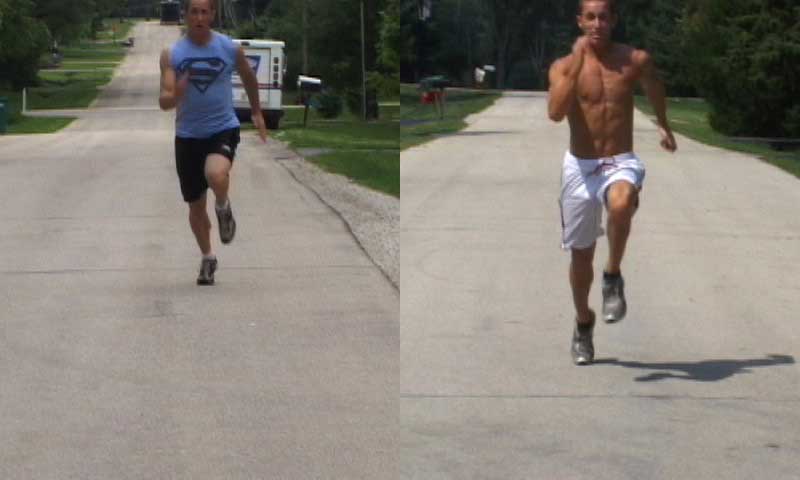
Frame 3: He is still staying on the outside of his foot. His hip has repositioned itself, so his foot is under his body. After. His drive is forward and not out to the side. His lateral aspect of the chain is holding strong, so the knee can come much higher. He is also making his way to a big toe departure as well.
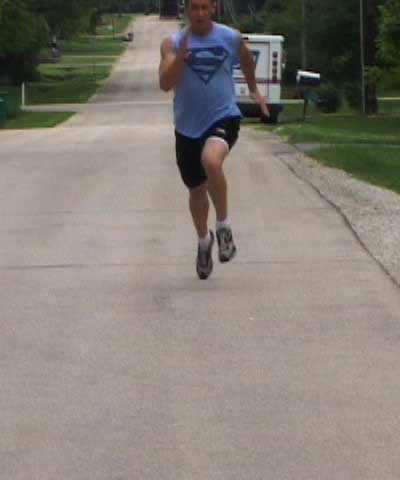
Frame 4: Toe-off. Now we can see where his hip rotation is coming from. At toe-off his hip is dropping down. I would guess that he lacks strength in his posterior portion of his glute medius., which is responsible for strength as the foot is rotated and past underneath center of mass. To deal with this issue, we did a ton of four way hip machine with is foot turned out. And we built a little knee bend and extension into the movement, like a kip in a chin. Running the mini hurdles with a lightweight (10-35 lbs.) overhead was another exercise that helped. I would like more of his big toe than the middle of his foot coming off the ground for some more power. There is no after frame here because he has already left the ground. This is due to quicker feet off the ground. So much for the rate vs. length controversy. It will happen when the body is ready. You can’t force either issue. They have to be earned.
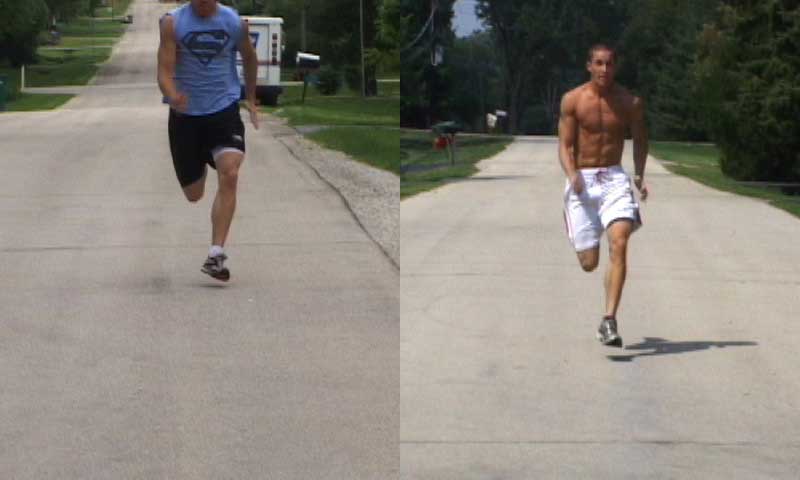
Frame 5: Pre-contact. Again, it looks like a lateral crash and out in front. Same as the other foot/Frame 1. Everything is much more square.
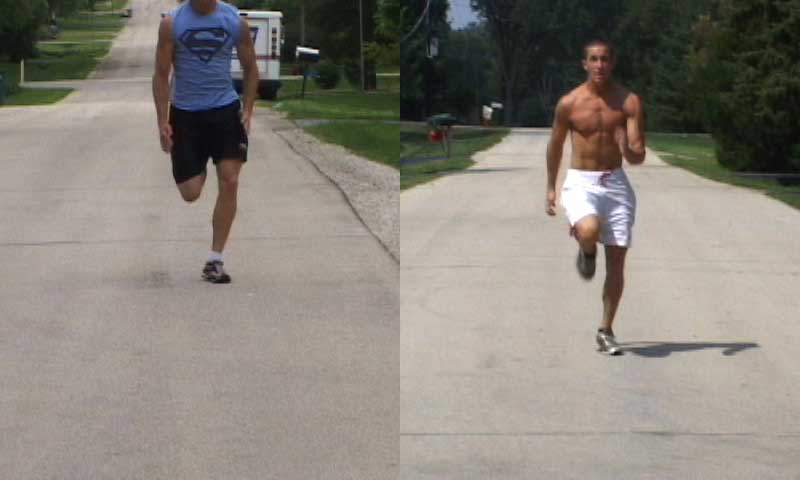
Frame 6: Mid-stance. The foot is in better placement, but the body seems to be rotated around the good placement. So that line straight up would be a good indicator that all is not well in Shane’s mid-stance. You can also see his swing leg knee is lower than his plant leg knee. This is usually an indicator that he lacks lateral strength. In this case, it ended up being his medial glute med and we did a ton of four way hip with the foot straight to help this. In the after side, as before, he is much straighter on the lateral aspect of his body. His foot is on the ground firmly. His knee is cycling through so fast that his swing leg knee is already out in front.
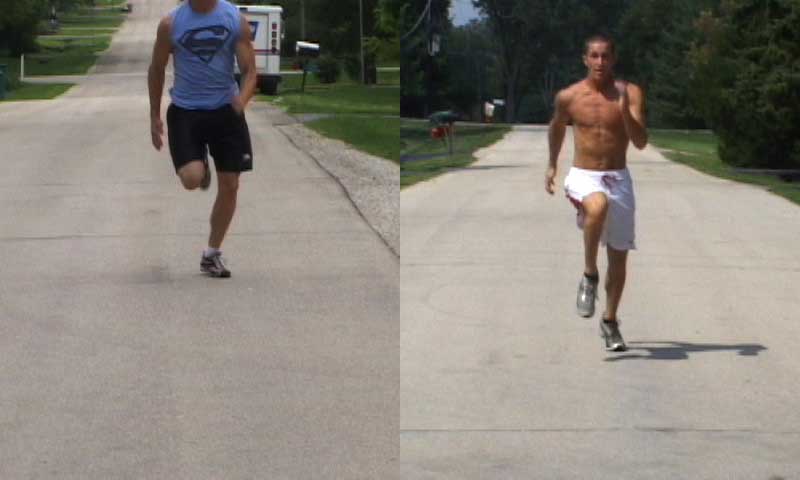
Frame 7: In this frame you can see his right hip sink, and his leg bow outward slightly. He is winding up to push himself down the track. If we watched at real time speed, I would guess that this stride is probably longer. But what is more interesting is his left heel. In the previous frame, the heel is to the outside more, and now it is more inward. He is spinning his heel. Or what I call a spinner. Something along the chain is causing his heel to spin which has a drastic impact on his form. The time it takes for his heel to get in a position to push increases contact time. When he does finally give impulse, the power is rotational and not straight. That can cause a bunch of muscular problems, especially in the hamstring. And it costs a lot of energy to have the weight of the body on a leg spin, straighten and push.. This is a common problem that can bedevil a coach. In the after frame, his ankle is different, and his foot is straighter. His hip line is level as well. This is where people could say that he runs taller. The glute medius is much stronger supporting the body. He has eliminated most of the twisting and sagging to the lateral part of his body as well.
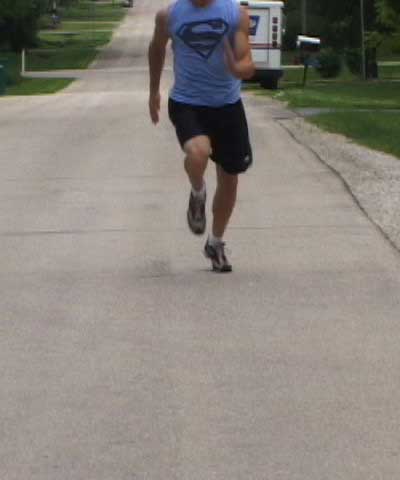
Frame 8: It takes him two frames to toe-off. See the comparison and improvement in the next frame.
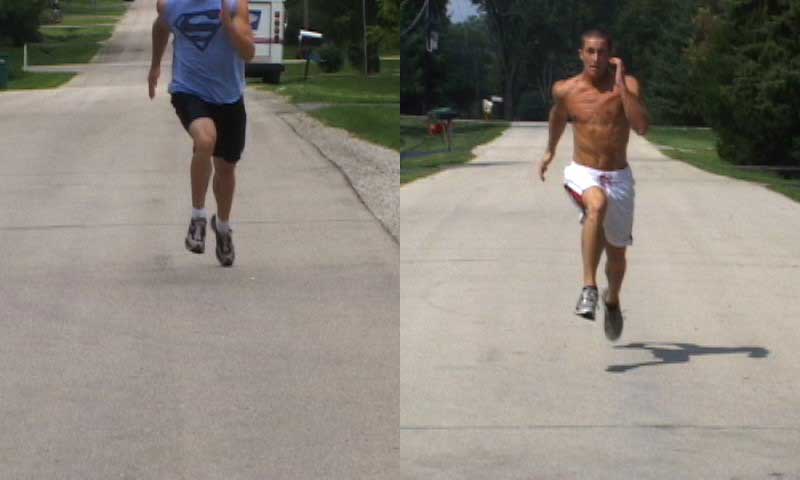
Frame 9: Shane gets a much bigger thrust in these two frames than he did with his right leg. Coincidentally, this is his take-off leg in the long jump. Also, he has a much better follow through to his big toe on this side. The after frame takes up the other two because he is already off the ground. What took him two frames before now takes him one.
That is quite a big difference in Shane over one year. Throughout the process. He increased his vertical from 28 to 40 inches. In future articles we look at his power output in a variety of lifts. And throughout the whole process, I eliminated all 2 legged exercise and most of his bodybuilding upper body workouts. We also changed his diet around as well. In another article, I will highlight the workouts that we went through, looking at the exercises and training. However, I will not get into long jump technique. The faster he ran, the further he jumped.
Please share this article so others may benefit.
[mashshare]


I look forward to reading your future articles dealing with the training you performed with this athlete. It will be interesting to see what was done and the reasoning for it. Will you be sharing what you did for upper body and diet wise?
Thanks and hope you had a great Christmas
I Think That The Way The Feet Contact The Ground Is Very Important Land On The Outter Edge Of The Foot And Roll Over To And Off Of The Big Toe ( Dr Peter Weyand )